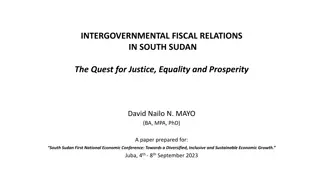Understanding Intergovernmental Transfers in Public Finance
The introduction to intergovernmental transfers (IGTs) provides insights into the flow of public funds between different levels of government, particularly focusing on the partnership between the federal government and states in funding programs like Medicaid. It covers topics such as the comparison of IGTs to Certified Public Expenditures (CPEs), allowable funding sources, and cash flow management. Examples and overviews illustrate how IGTs work in practice, highlighting the intricate financial mechanisms involved in funding public services.
- Intergovernmental transfers
- Public finance
- Medicaid funding
- Government partnerships
- Financial management
Download Presentation

Please find below an Image/Link to download the presentation.
The content on the website is provided AS IS for your information and personal use only. It may not be sold, licensed, or shared on other websites without obtaining consent from the author. Download presentation by click this link. If you encounter any issues during the download, it is possible that the publisher has removed the file from their server.
E N D
Presentation Transcript
Introduction to Intergovernmental Transfers October 13, 2022
Agenda Overview of Intergovernmental Transfers (IGTs) Comparison of IGTs to Certified Public Expenditures (CPEs) Allowable and Non-Allowable IGT Funding Sources Cash Flow Overview of County Fund Accounts (CFAs) 1
Please click on the link in the chat box and answer questions 3 minutes to answer questions PRE-TRAINING ASSESSMENT 2 2
Overview of IGTs Medicaid is a jointly funded partnership between the federal government and the states States may use state general fund revenue, local contributions (i.e., IGTs and CPEs) and provider taxes as the match for federal funds Section 1903(w)(6) of the Social Security Act and 42 Code of Federal Regulations Section 433.51 recognize the state s ability to use IGTs and CPEs IGTs represent transfers of public funds between or within levels of government (i.e., the transfer of funds from the county to the state) 3
Overview of IGTs County 4 1. County transfers $10 million to State DHCS 2. Federal government provides matching federal funds in the amount of $10 million 3. State DHCS makes a $20 million payment to County
Overview of IGTs IGT amount equals the local/county match required for approved Medi-Cal services Medi-Cal service Medi-Cal Fee Schedule Medi-Cal Aid Code Federal Medical Assistance Percentages Any Prop 30/State General Fund amounts Behavioral Health Plan Administration and Utilization Review will require IGTs Proposed 15% of direct service payments for BHP Administration UR based on hours and costs FFS/MC hospital payment process is proposed to remain unchanged State pays hospital in full State receives FFP State offsets 1991 realignment for local match (Managed Care Offset) 5
Overview of IGTs-Example Provider enters CPT code 90834 into Behavioral Health Plan s claiming system which has a rate of $242.10 per unit of service for the BH Plan SD/MC system adjudicates claim and determines $121.05 is federal share and $121.05 is local/county share Medi-Cal Beneficiary receives 45 minutes of therapy from a provider BH Plan submits claim to DHCS s Short- Doyle/Medi-Cal system BH Plan provides $121.05 IGT and receives $242.10 payment from the State 6
Comparison of IGTs to CPEs Certified Public Expenditures (CPEs) are a permissible source of local funding used to receive federal Medicaid matching funds Local government entities certify that they have incurred a CPE on items and services that are eligible for Medi-Cal funding CPEs do not require a transfer of funds between government entities 7
Comparison of IGTs to CPEs 8 1. County incurs CPE of $100 million and submits certification to State DHCS 2. State DHCS reports the $100 million CPE to the federal government 3. Federal government provides $50 million in federal matching funds
Comparison of IGTs to CPEs CPEs IGTs Requires a full expenditure be incurred by the local agency for Medi-Cal eligible services Local agency can not claim for Medi-Cal services until a service has been provided and a CPE has been incurred Rates claimed for services equal the costs incurred by local agency Requires a transfer of local matching funds to State DHCS Local agency can claim for Medi-Cal services after service is provided irrespective of timing or amount of actual expenditures Rates claimed for services are not required to equal the costs incurred by local agency 9
Comparison of IGTs to CPEs-CPE Example Provider enters Mode 15, Service Function Code 40 into Behavioral Health Plan s claiming system which has a contract rate of $4.00 per minute of service for the provider Medi-Cal Beneficiary receives 45 minutes of therapy from provider and provider incurs 15 minutes documentation time SD/MC system adjudicates claim and determines $120 is federal share and $120 is local/county share BH Plan pays provider $240 for 60 minutes of Mode 15, Service Function Code 40 BH Plan submits $240 claim to DHCS s Short- Doyle/Medi-Cal system BH Plan receives $120 payment from the State 10
Allowable and Non-Allowable IGT Funding Sources 42 CFR Section 433.51(c) generally requires that Federal funds cannot be considered as the State s share in claiming Federal Financial Participation Exception for Federal funds that are authorized by Federal law to be used to match other Federal funds Behavioral health funds that cannot be used to fund IGT SAMHSA Mental Health Block Grant SAMHSA Substance Abuse Block Grant 1991 and 2011 Realignment Mental Health Services Act (to the extent permissible by the Act) State General Fund County General Funds Behavioral health funds that can be used to fund IGT 11
Cash Flow County Behavioral Health Plans will generally incur an expenditure in addition to providing the IGT Source of IGT does not have to be the same as the expenditure Could create cash flow issues for County BH Plans DHCS has developed several proposals to help mitigate cash flow issues County Fund Accounts (CFAs) would lessen the time required for the county to receive full payment 12 *Information on CFAs is pre-decisional (DHCS policy still in development as of 10.13.22).
Overview of County Fund Accounts (CFAs) DHCS has proposed County Fund Accounts (CFAs) for use as the IGT Each county would have two CFAs One for Medi-Cal Specialty Mental Health and one for Drug Medi-Cal/DMC-ODS DHCS is proposing to start with three months of estimated IGT funding as the CFA fund balance Based on individual county historical approved claims For each approved claim, DHCS would withdraw funds from the CFAs to use as the IGT If a CFA does not have sufficient funding to meet the IGT obligations of a claim, DHCS will pend the claim until sufficient funding has been deposited into the CFA 13 *Information on CFAs is pre-decisional (DHCS policy still in development as of 10.13.22).
Overview of County Fund Accounts (CFAs) DHCS will provide a monthly CFA report to the county Beginning balance Monthly transactions Ending balance Recommended IGT amount necessary to maintain appropriate CFA balance DHCS has proposed a withhold or wire transfer process DHCS will hold claims if insufficient funding is in the CFA This incentivizes the county to supply funds promptly 14 *Information on CFAs is pre-decisional (DHCS policy still in development as of 10.13.22).
Next Steps Register for the November 3rd IGT webinar Relationship between CFAs and IGTs Determining optimal funding sources to use as IGTs Withholds and wire transfers IGT and CFA reconciliation considerations IGT and CFA dispute resolution process Education of County Stakeholders on IGTs and CFAs 15
Questions & Answers Please type your questions in the chat 16
Post-Training Evaluation Please click on the link in the chat box and answer questions to provide feedback 17
Thank You Thank you for attending this webinar! The recording and slides will be available on our website on the following day. Please send your questions/comments to paymentreform@calmhsa.org. 18























